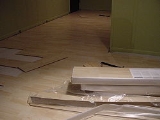
Laminate flooring
Encyclopedia

Flooring
Flooring is the general term for a permanent covering of a floor, or for the work of installing such a floor covering. Floor covering is a term to generically describe any finish material applied over a floor structure to provide a walking surface...
product fused together with a lamination
Laminate
A laminate is a material that can be constructed by uniting two or more layers of material together. The process of creating a laminate is lamination, which in common parlance refers to the placing of something between layers of plastic and gluing them with heat and/or pressure, usually with an...
process. Laminate flooring simulates wood (or stone, in some cases) with a photographic applique
Applique
In its broadest sense, an appliqué is a smaller ornament or device applied to another surface. In the context of ceramics, for example, an appliqué is a separate piece of clay added to the primary work, generally for the purpose of decoration...
layer under a clear protective layer. The inner core layer is usually composed of melamine resin
Melamine
Melamine is an organic base and a trimer of cyanamide, with a 1,3,5-triazine skeleton. Like cyanamide, it contains 66% nitrogen by mass and, if mixed with resins, has fire retardant properties due to its release of nitrogen gas when burned or charred, and has several other industrial uses....
and fiber board materials. There is sometimes a glue backing for ease of installation. It has the advantages of being attractive, while costing less than natural floor materials, and of being more durable than carpet.
Installation
Laminate floors are reasonably easy for a do-it-yourself homeowner to install. Laminate flooring are packaged as a number of tongue and grooveTongue and groove
A strong joint, the tongue and groove joint is widely used for re-entrant angles. The effect of wood shrinkage is concealed when the joint is beaded or otherwise moulded...
planks - these can be clicked into one another. Installed laminate floors typically "float" over the sub-floor on top of a foam/film underlayment, which provides moisture- and sound-reducing properties. A small (1-10mm) gap is required between the flooring and any immovable object such as walls, this allows the flooring to expand without being obstructed. Baseboards
Baseboard
In architecture, a baseboard is a board covering the lowest part of an interior wall...
(skirting boards) can be removed and then reinstalled before and after laying of the flooring is complete for a neater finish, or small beading trims can be fitted to the baseboards (skirting boards). Saw cuts on the planks are usually required at edges, and around closet and door entrances.
Care
It is important to keep laminate clean, as dust, dirt and sand particles may scratch the decorative surface over time in high-traffic areas. It is also important to keep laminate relatively dry, since sitting water/moisture can cause the planks to swell, warp, etc, though some brands are equipped with water-resistant coatings. Water spills aren't a problem if they're wiped up quickly, and not allowed to sit for a prolonged period of time.Adhesive felt pads are often placed on the feet of furniture on laminate floors to prevent scratching.
Inferior glueless laminate floors may gradually become separated, creating visible gaps between planks. It is important to "tap" the planks back together using the appropriate tool as you notice the gaps, otherwise dirt will fill the gaps making it difficult to close them later.
Quality glueless laminate floors use joining mechanisms which hold the planks together under constant tension which prevent dirt entering the joints and do not need "tapping" back together periodically.
Potential health effects
Laminate flooring is often made of melamine resinMelamine resin
Melamine resin or melamine formaldehyde is a hard, thermosetting plastic material made from melamine and formaldehyde by polymerization. In its butylated form, it is dissolved in n-butanol and xylene. It is then used to cross-link with alkyd, epoxy, acrylic and polyester resins, used in surface...
, a compound made with formaldehyde
Formaldehyde
Formaldehyde is an organic compound with the formula CH2O. It is the simplest aldehyde, hence its systematic name methanal.Formaldehyde is a colorless gas with a characteristic pungent odor. It is an important precursor to many other chemical compounds, especially for polymers...
. There has been increasing concern about indoor air quality
Indoor air quality
Indoor air quality is a term referring to the air quality within and around buildings and structures, especially as it relates to the health and comfort of building occupants....
from releases of volatile organic compounds from building materials made with formaldehyde.
Some laminate flooring (parador proair) uses a chemical process to reduce and neutralise formaldehyde emissions throughout the life of the floor.
History
Laminate flooring was invented in 1977 by the Swedish company Perstorp, and sold under the brand name Pergo. They had been making laminate surfaces since 1923. The company first marketed its product to Europe in 1984, and later to the United States in 1994. Perstop spun off its flooring division as the separate company named Pergo, now a subsidiary of PfleidererPfleiderer
Pfleiderer is a German building material company headquartered in Neumarkt in der Oberpfalz, Germany. It specializes in the production of medium-density fibreboard, laminate and particle board. Subsidiaries include laminate company Pergo....
. Pergo is the most widely known laminate flooring manufacturer, but the trademark PERGO is not synonymous for all laminate floors.
Glueless laminate flooring was invented in 1996 by the Swedish company Välinge Aluminium (now Välinge Innovation) and sold under the names of Alloc and Fiboloc. However, a system for holding flooring panels together was also developed in parallel by the Belgian company Unilin in and released in 1997.
The two companies have been in a great number of legal conflicts over the years, and today most, if not all glueless locking flooring is made under license from either Välinge, Unilin or even a combination of both.

